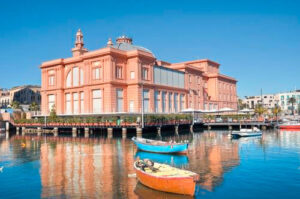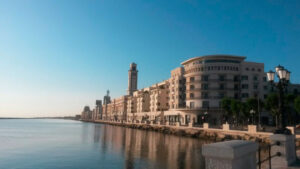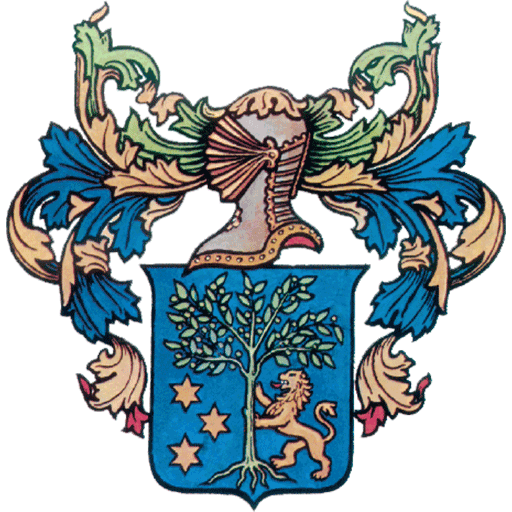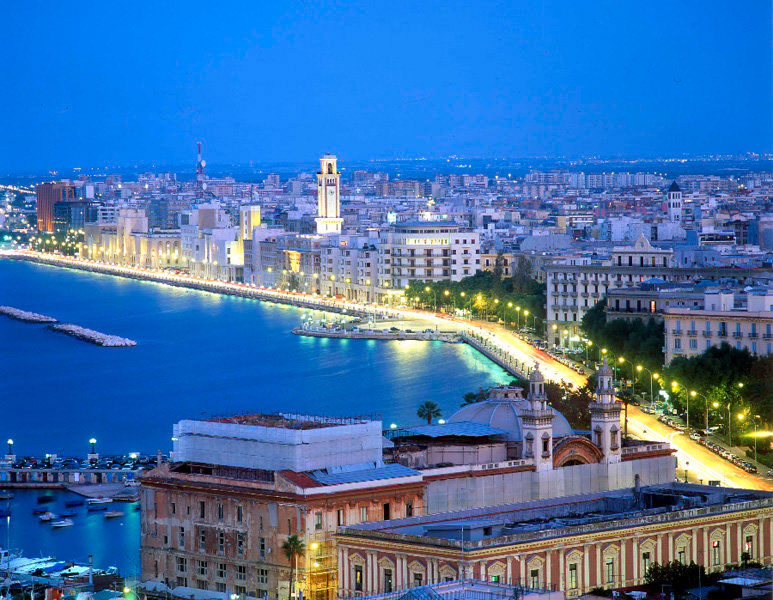
BARI
“If Paris had the sea it would be a little Bari”
Index
Bari has a tradition of merchants and entrepreneurs and has always been a center of commercial, political and cultural exchanges with the Middle East. Its port is the largest Italian port for passenger ships on the Adriatic Sea. The Fiera del Levante, leader in Italy, has been held in Bari since 1930.
The city is also known as the resting place of the relics of St. Nicholas. This makes Bari and its basilica a privileged center for the Western Orthodox Church, as well as an important center of extra-denominational communication between Orthodox and Catholics.

Where is Bari located?
La città si affaccia sul Mare Adriatico fra i comuni di Giovinazzo, a nord, e Mola di Bari, a sud per una lunghezza territoriale e comunale di circa 42 chilometri
The city area is at the center of the Bari Basin, a vast area of plains and valleys. However, in the center it extends for several kilometers inland to the municipalities of Capruso, Torrigiano, Bitritto, Modugno and Bitonto, where it joins the first slope of the Murge river. It is located between 0 and 131 m above sea level. The Town Hall is located in via Vittorio Emanuele, the main street of the city, overlooking the Margherita Theater to the east and the sea, 5 meters high.
The conformation of the city is often described as an eagle with outstretched wings, whose head is the small peninsula on which the first urban center, Bari Vecchia, was built; conformation that they wanted to give to the agglomeration and the municipal territory especially in the Fascist era.
What to see in Bari?
The city is rich in history, which has contributed to giving it, over the centuries, a significant cultural heritage, essentially of an architectural nature, which since the 2000s has been in constant rediscovery and enhancement, mainly the great Basilica or the Cathedral of San Sabino, the three main theaters of the city, the Piccinni, first for construction, the Petruzzelli, first for importance, and the Margherita, which was built on the sea for the agreements between the family that owns the Petruzzelli and the Municipality of Bari, but also the two stadiums, the San Nicola, built for the World Cup in Italy ’90, and the Arena della Vittoria, built in 1934 as the first real stadium in Bari and which hosted Bari matches until 1990, symbols of two different eras of the twentieth century, the fascist one and that of the Economic Boom. Together with this there are other important architectures:
What to eat in Bari? Where to eat in Bari?
The Bari focaccia
The focaccia from Bari is a delicacy …
Soft, greased to the right point (even a little more!), Covered with fresh cherry tomatoes, olives and oregano: it is irresistible.
You can eat it for lunch, as a snack or as a mid-morning snack: there is no precise time to enjoy this goodness … it is always the right time to do it!
The fried panzerotto
Vuoi assaggiare i piatti tipici della cucina di Bari? prenota ora il tuo tavolo!
Half moons of pasta stuffed with tomato and mozzarella (in the classic version) and fried in boiling oil.
For some they can be a real lunch… for many others a greedy snack before trying the other delights of the city!
The popizze from Bari
In many other parts of Puglia they take the name of pettole, the popizze from Bari are round pancakes made with leavened dough.
They can be enjoyed alone, or they can accompany cold cuts, cheeses and vegetables in oil and vinegar as a real appetizer.
During the Christmas period they are also eaten in the sweet version covered with sugar.
Raw fish
Do you want to miss fish in a seaside city like Bari?
Among the street food of the Apulian capital, raw fish is a real must: urchins, mussels, squid, octopus and cuttlefish are the protagonists of the street food of the city and are sold freshly caught to enjoy the true taste of the sea.
Orecchiette with turnip tops
Orecchiette with turnip tops known all over the world: they are a typical dish of Puglia. Thanks also to the catchphrase, which over the years the famous Lino Banfi, has consistently spread in various films and television broadcasts; where at times he has also improvised as a cook.
Although this is a dish made all over Puglia, in Bari they attribute the real birth to us, as a symbol of the tradition and authenticity of a territory.
Potatoes, rice and mussels
It is said that St. Nicholas is a lover of foreigners, it is no coincidence; precisely to understand that with us the stranger integrates with the local. This is due to the multicultural exchange, the curiosity for different cultures, the welcome, the traditions; these are all characteristics of a city that today can be said to be multiethnic, just like the great capitals of the world.
But on how to prepare the tièdd of potatoes, rice and mussels, no mistakes or contaminations are allowed. The tièdd is a pride and tradition of the Bari cuisine.
Spaghetti all’assassina
Like other typical dishes, this is one of the symbols of Bari, here’s how to prepare them strictly respecting tradition.
The recipe consists of: Spaghetti, tomato puree, tomato paste, oil, garlic and sugar and finally chilli. The process starts from the dry spaghetti, rehydrated according to the risottatura technique, over a very high heat, and perform a real caramelization. All to be cooked in a non-stick pan, even if tradition has it that it is cooked in the iron one.
Burnt, crunchy, spicy: these are the three fundamental characteristics of spaghetti all’assassina, another of the typical dishes of the city of Bari.
The history of Spaghetti all’Assassina appears recent, in Bari already known as “Spaghetti burnt” and perhaps born as a Sunday recovery dish.
Visita il nostro Bed & Breakfast a Bari dove alloggiare per poterla visitare.
What to do in Bari?
In recent years, urban changes have led to a revaluation of the elegant Murattino and Umbertino districts, the charming old town of Bari and the beauty of the waterfront. A facelift in line with trends. Bari is the only Italian destination listed among the best European destinations in Lonely Planet’s “Best of Europe 2019” ranking. It is the first Apulian city for overnight stays and the fourth for stays, also thanks to 16 new flights in 2018 and another six in 2019, which have increased the number of international visitors. Located on the Adriatic Sea, the city offers weekend trips and a series of events organized by the Wine Tourism Movement, Buonaterra and Author Events throughout the year that will make you travel alone. But what is worth seeing in Bari?
Bari Vecchia
The ancient center is located in Bari Vecchia, where the tuff buildings rise in a maze of alleys. It overlooks Piazza Merciantile, the ancient commercial and administrative center of the city, whose 13th-century columns of justice, adorned with stone lions and freed from the long suffocating asphalt, now shine with a clear sheen. Around it are the Palazzo del Sedile, built in 1543 and completed in the 18th century, which housed the council of the local nobility, and the Palazzo della Dogana, built in the 16th century. And the numerous trattorias where the people of Bari meet. Vico Sant’Agostino also has a restaurant called La Uascezze. It is a dialect word that means a festive meal. On the tables inside the ancient walls you will find Martina’s capocollo, the old-fashioned chickpea soup, the chop with sauce …
The basilica of San Nicola and the cathedral of San Sabino
Bari Vecchia welcomes ancient churches. Among these, the Basilica of San Nicola, founded in the year 1000, which houses the tomb of the patron saint in the crypt. In the rich interior that contrasts with the simplicity of the exteriors, the gilded wooden ceilings with the seventeenth-century paintings of the painter Carlo Rosa amaze. To which are added the Chair of Elijah, the medieval capitals, the silver altar. Also interesting are the nearby Basilica of San Gregorio and the Cathedral of San Sabino. The first, the oldest in Bari, is a weekly meeting place for Orthodox Romanians. Built in the 13th century, the Cathedral also impresses with its beautiful Romanesque. He is the protagonist of a curious phenomenon. On June 21 at 5 pm, the light beams that penetrate from the rose window of the façade are projected onto the marble mosaic of the floor, until they match perfectly.
Underground Bari and the Norman Swabian Castle
The cathedral is one of the entrances to the underground world of Bari, a journey that leads to the discovery of the surprising city beneath the streets and squares of the world above. Saccopo, where the remains of the Roman and medieval period are visible. Among these, a beautiful polychrome mosaic commissioned by Timoteo as an ex-voto. The cellars of Bari can be visited through the Author Events, accompanied by an authorized archaeologist. Not far away is the Norman-Swabian castle guarding the Bari Vecchia peninsula: built by the Normans in the 12th century, it was destroyed in 1156 but rebuilt around 1230 by order of King Frederick II. Today it hosts exhibitions and shows and in the ground floor room you can visit the Gipsoteca, a plaster cast of the sculptures of the most famous Apulian monuments, created for the provincial exhibition in Rome in 1911. An underground passage leads to a 10th century Byzantine settlement, which predates the castle.
The Murattian and Umbertine neighborhoods
That Bari is a unique city is demonstrated by the strong contrast between the ancient and the modern part of the city. The Murattino district, behind via Vittorio Emanuele II, is the perfect chessboard created during the Napoleonic expansion of the city: stroll along via Sparano da Bari the shopping street. Between the windows of famous brands and the post-war buildings peep out splendid Art Nouveau buildings.
The Umbertino district, stretching towards the sea, is dominated by the Liberty style with the famous Petruzzelli Theater. However, the long-abandoned Teatro Margherita has been restored as a venue for exhibitions and events, while the Quasar di Santa Lucia remains closed. Since November last year the foyer and, as the name suggests, the former ticket office, has been brought back to life.
Visita il nostro B&B a Bari dove alloggiare per poterla visitare.
The history of Bari:
It became part of the Roman domain in the third century BC. as a municipium, Barium developed following the construction of the Via Traiana. It was equipped with a mighty castle, a mint, a pantheon for its pagan divinities and most likely a theater (as can be deduced from an epigraph of a freedman found in the succorpo of the Cathedral, but of which no archaeological evidence has emerged).
From the fourth century, it was an episcopal seat (it was known as ecclesia varina, as we read in a dedication on the floor of a hall of the early Christian church below the current Cathedral) and after the fall of the Roman Empire it was disputed between the Lombards and Byzantines (the current structure of the “old city” dates back to this period, and is articulated around the court of the Catapano).
Later it was in the hands of the Arabs (from 847 to 871 it was the seat of an emirate) and therefore of the Lombard dukes of Benevento. In 875 it returned to the Byzantines who created it the capital of the thema of Langobardia, including Apulia and Calabria.
Freed, after six months of siege by the Saracens, from the Venetian fleet, in 1002 it rebelled under the leadership of Melo di Bari (noble from Bari) against the fiscal government of the Byzantine catapano, managing to obtain its autonomy in 1018.
Last Byzantine possession in Italy, in 1068, the city of Bari was besieged by the Normans, who snatched it from the Byzantines in 1071, and in 1087 the remains of St. Nicholas of Myra were brought there. Between the 12th and 14th centuries it was the port of departure for the Crusades.
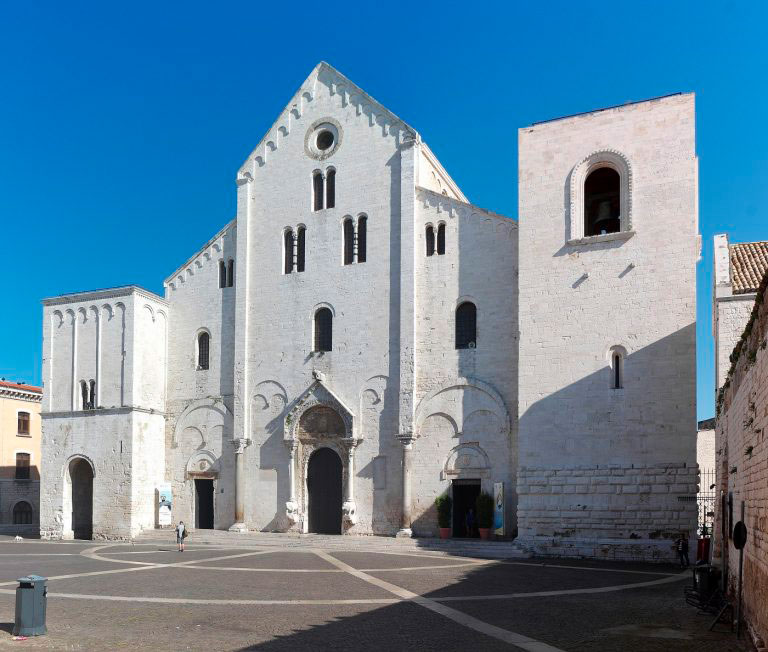
In 1098 in the crypt of the new basilica of San Nicola, the council presided over by Pope Urban II met, attended by over 180 bishops who met to discuss dogmatic problems inherent in the relations between the Orthodox Church and the Roman Church in the aftermath of the Great Schism.
Destroyed by William the Bad in 1156, it flourished again in the Swabian era, around the castle built by Frederick II on pre-existing Norman fortifications, commemorated by a Stauferstele.
A long period of decline (mainly due to the oppressive policy of the ruling governments) characterized the city under the domination of Alduino Filangieri di Candida, Master of the Royal Court and executioner of Bari from 1284, and the Angevin, Aragonese and Spanish ones, interrupted by the splendor below. the Sforza, with the duchesses Isabella d’Aragona and Bona Sforza. Bari also underwent the Venetian domination, thanks to which there was the expansion of the port and a very flourishing period, also favored by the trade of inland products, in great demand on foreign markets. In 1556 Princess Bona Sforza D’Aragona, second wife of the King of Poland Sigismund I the Elder from 1518, left Poland and settled in Bari of which she had inherited the principality. Bona Sforza died in 1557.
Scegli la tua dimora! per dormire vicino a Bari in B&B con piscina.
Where to sleep in Bari?
Vuoi visitare Bari e risparmiare sul prezzo del B&B? Verifica le nostre disponibilità e chiedici uno sconto!
Why visit Bari?
Previously considered only as a cold and working-class port, welcoming Bari today is pervaded by a new energy and charge.
The only Italian destination among the best European destinations in the Lonely Planet ranking, it has earned the title of first city in Puglia for number of overnight stays. Thanks to the urban changes that have restored beauty to the ancient and modern part, Bari reserves surprises. Between cathedrals, theaters and good food
RELATED ARTICLES
Agriturismo Masseria Alberotanza B&B e Ristorante a Conversano
Secondary phone: +393317271337
Email: info@masseriaalberotanza.it


